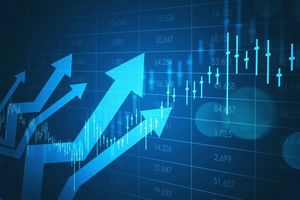
The global financial markets are witnessing an unprecedented surge in precious metals, as both gold and silver have shattered previous records, reaching new all-time highs on September 30, 2025. Contrary to scenarios of a market downturn, these safe-haven assets are experiencing a robust bull run, fueled by escalating geopolitical tensions, expectations of further interest rate cuts by the U.S. Federal Reserve, and a weakening U.S. Dollar. Notably, silver has emerged as a standout performer, demonstrating a more significant percentage gain year-to-date compared to its yellow counterpart, signaling a potentially profound shift in investor sentiment and market dynamics.
This remarkable rally underscores the enduring appeal of precious metals as hedges against inflation and economic instability. With gold nearing the psychological $4,000 per ounce mark and silver breaching $47 per ounce, the immediate implications for investors are substantial. The elevated Gold/Silver ratio, currently hovering around 81.4, suggests that silver may still be undervalued relative to gold, hinting at considerable upside potential should the ratio revert to its historical mean. This market behavior prompts a deeper analysis into the drivers of this surge, the outlook for both metals, and the critical role of the U.S. Dollar in shaping their trajectory.
Unpacking the Historic Rally: Gold and Silver Reach Uncharted Territories
September 30, 2025, marked a historic day for precious metals, as both gold and silver soared to unprecedented levels, defying any notion of a market downturn. Spot gold traded between approximately $3,842.76 and $3,866.90 per ounce, while December gold futures (COMEX: GC00) climbed to $3,895.22 per ounce, setting a new lifetime high. This remarkable performance positions gold for its best monthly gain in over a decade, with an impressive 11% increase in September alone and a staggering 45% surge since the beginning of 2025. In parallel, spot silver (COMEX: SI00) touched $47.41 per ounce, with December silver futures rising to ₹1,44,200 per kilogram on the MCX, also reaching a new peak. Silver's ascent has been even more dramatic in percentage terms, boasting an 18.2% increase in September and a nearly 37% return year-to-date on the MCX, significantly outpacing gold.
This powerful rally is not a sudden anomaly but the culmination of several reinforcing global economic and geopolitical factors. A primary driver is the pervasive safe-haven demand, as escalating global uncertainties, including fears of a potential U.S. government shutdown and ongoing geopolitical hotspots, push investors towards traditional stores of value. Coupled with this, growing expectations of further interest rate cuts by the U.S. Federal Reserve are boosting the allure of non-yielding assets like gold and silver. A lower interest rate environment reduces the opportunity cost of holding these metals and typically leads to a weakening U.S. Dollar, making dollar-denominated commodities more attractive to international buyers.
Adding to gold's momentum is the sustained central bank buying, a trend indicative of a broader de-dollarization movement among institutional investors diversifying their reserves. For silver, its dual identity as both a precious metal and a critical industrial commodity provides additional tailwinds. Robust industrial demand from rapidly expanding sectors such as electric vehicles, solar energy, and electronics is fueling a significant portion of its growth. This marks the fifth consecutive year that global silver demand is projected to outstrip supply, leading to a persistent supply deficit. Initial market reactions have been overwhelmingly positive, with analysts predicting continued strength, although some profit-booking was observed in the afternoon session as prices touched record highs, leading to slight pullbacks.
Miners Poised for Prosperity: Identifying Winners and Losers in the Precious Metals Boom
The unprecedented surge in gold and silver prices presents a golden (and silver) opportunity for public companies operating within the precious metals mining and streaming sectors. Mining giants with significant exposure to these commodities are poised to see substantial revenue and profit growth. Companies like Barrick Gold Corp. (NYSE: GOLD), one of the world's largest gold miners, and Newmont Corp. (NYSE: NEM), another leading gold producer, stand to benefit immensely from higher gold prices. Their extensive reserves and operational scale mean that every upward tick in the price of gold directly translates into improved financial performance, potentially leading to increased dividends or share buybacks for investors.
Similarly, companies with substantial silver production will capitalize on silver's outperformance. Pan American Silver Corp. (NASDAQ: PAAS), a major silver miner, and Wheaton Precious Metals Corp. (NYSE: WPM), a leading precious metals streaming company with significant silver interests, are particularly well-positioned. Wheaton's streaming model, which involves purchasing a portion of a mine's future precious metal production at a fixed, low cost, allows it to benefit disproportionately from rising spot prices without direct exposure to mining operational costs and risks. The strong industrial demand for silver further bolsters the outlook for these companies, as it provides a stable demand floor beyond traditional investment motives.
Conversely, companies heavily reliant on the consumption of precious metals as raw materials, particularly in manufacturing or jewelry, might face increased input costs. However, given the current strong demand environment, many of these costs are likely to be passed on to consumers. The primary "losers" in this scenario might be those who bet against the precious metals rally or who are under-hedged in their portfolios. Financial institutions and investors with significant short positions in gold and silver futures could face considerable losses as prices continue their upward trajectory. Overall, the prevailing sentiment is one of opportunity for producers and a call for strategic adjustments for others in the value chain.
Broader Implications: De-Dollarization, Industrial Demand, and Historical Parallels
The current precious metals rally transcends mere market speculation, signaling profound shifts in the global financial landscape. This event fits squarely into broader industry trends, most notably the accelerating de-dollarization movement. Central banks globally are actively diversifying their reserves away from the U.S. Dollar, increasing their gold holdings as a hedge against currency volatility and geopolitical risks. This strategic pivot by sovereign entities provides a robust, long-term demand floor for gold, reinforcing its role as a global reserve asset. The weakening U.S. Dollar, a significant factor in the current rally, further incentivizes this shift, making dollar-denominated assets less attractive.
The unique strength of silver in this rally, outperforming gold in percentage terms, highlights the growing importance of its industrial demand. The rapid expansion of green technologies—such as solar panels, electric vehicles, and 5G infrastructure—is creating an insatiable appetite for silver. This structural demand component differentiates silver from gold, providing an additional layer of support beyond its traditional safe-haven appeal. This trend has potential ripple effects on competitors and partners, as companies involved in these green technologies will increasingly rely on a stable and affordable supply of silver, potentially driving innovation in silver recycling and alternative materials.
Analyzing the Gold/Silver ratio, currently at approximately 81.4, provides crucial insights into the market's perception of these metals. Historically, the ratio has averaged around 60, and even lower in ancient times. An elevated ratio like the current one suggests that silver is significantly undervalued relative to gold. This divergence from historical means often precedes a period where silver outperforms gold to "catch up," either through silver prices rising faster, gold prices correcting, or a combination of both. Historical precedents, such as the 2011 surge when the ratio briefly dropped to 35:1, demonstrate silver's potential for explosive gains when the market re-evaluates its intrinsic value and industrial utility. This implies significant upside potential for silver as the market seeks equilibrium.
What Comes Next: Navigating the Future of Precious Metals and the Dollar
The path forward for gold, silver, and the U.S. Dollar appears poised for continued volatility and significant opportunities. In the short term, the precious metals market is likely to remain highly sensitive to incoming economic data, statements from the U.S. Federal Reserve regarding interest rates, and geopolitical developments. Any further indications of slowing economic growth or increased global instability could provide additional impetus for safe-haven buying. Conversely, unexpected hawkish shifts from central banks or a sudden strengthening of the U.S. Dollar could trigger profit-taking and temporary pullbacks. However, with the underlying drivers of the rally still firmly in place, such dips are likely to be viewed as buying opportunities, particularly for silver given its perceived undervaluation.
In the long term, the outlook for both gold and silver remains robust. Analysts are increasingly projecting gold to target $4,000 per ounce by mid-2026, with some even forecasting higher. For silver, the projections are even more aggressive, with some experts anticipating prices could reach ₹2.5 lakh per kg (approximately $75-$80 per ounce) within the next six months, driven by its strong industrial demand and the potential for the Gold/Silver ratio to normalize. This sustained bull market could necessitate strategic pivots for investors and businesses alike. Mining companies may accelerate exploration and production efforts, while investors might rebalance portfolios to increase exposure to precious metals, especially silver.
Potential scenarios include a continued weakening of the U.S. Dollar as global central banks diversify and the Fed maintains an accommodative monetary policy. This would further boost dollar-denominated commodities. Another scenario involves persistent geopolitical fragmentation, making safe-haven assets indispensable. Market opportunities may emerge in related sectors, such as precious metals streaming and royalty companies, as well as in innovative technologies that utilize silver. The primary challenge will be managing volatility and discerning genuine long-term trends from short-term fluctuations, requiring investors to remain agile and informed.
Comprehensive Wrap-up: A New Era for Precious Metals
The current financial landscape, as of September 30, 2025, is unequivocally marked by a historic rally in precious metals. The key takeaway is that both gold and silver are not merely holding their value but are actively appreciating, driven by a powerful confluence of safe-haven demand, expectations of Federal Reserve rate cuts, a weakening U.S. Dollar, and persistent geopolitical tensions. Silver, in particular, has emerged as the star performer, outshining gold in percentage gains due to its dual role as a precious metal and a critical industrial commodity, with demand significantly outstripping supply.
Moving forward, the market appears poised for continued strength in precious metals. The elevated Gold/Silver ratio, currently around 81.4, serves as a compelling indicator that silver remains undervalued relative to gold, suggesting significant upside potential as the ratio converges towards its historical average. This implies that while gold maintains its status as the ultimate safe haven, silver offers a unique blend of investment appeal and growth potential driven by the burgeoning green economy. The U.S. Dollar's trajectory will continue to be a critical determinant, with further weakness likely to fuel the rally in dollar-denominated commodities.
Investors should watch for sustained central bank buying, further developments in global economic policy, and any shifts in industrial demand for silver. The current environment strongly suggests that precious metals, especially silver, should be a significant component of diversified portfolios. This era marks a potential re-evaluation of monetary assets and industrial commodities, with lasting impacts on global finance and manufacturing. The message is clear: the age of precious metals is far from over; indeed, it may just be entering a new, dynamic phase.
This content is intended for informational purposes only and is not financial advice.





